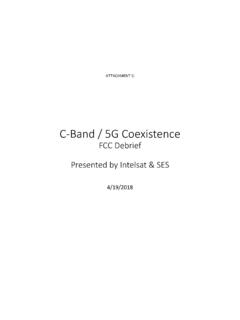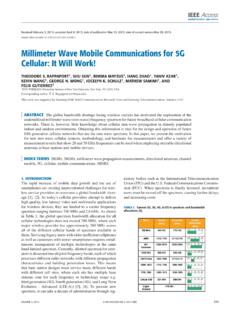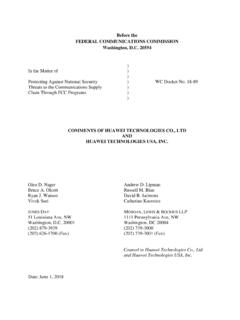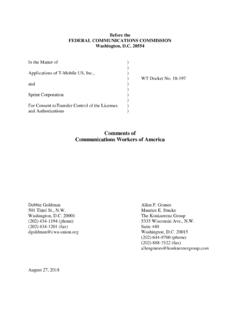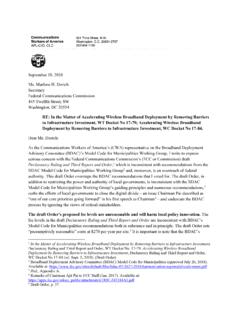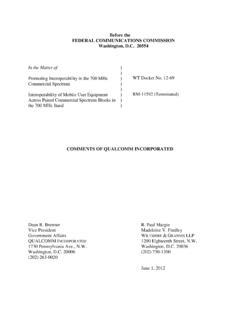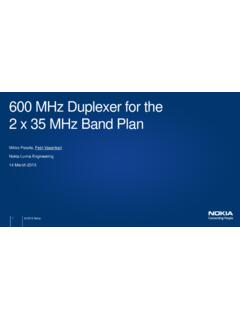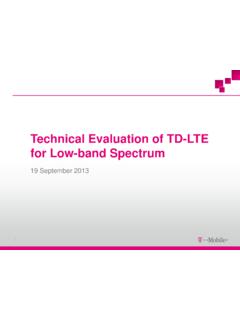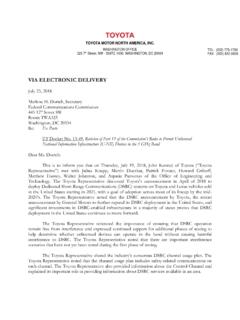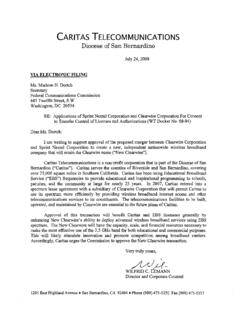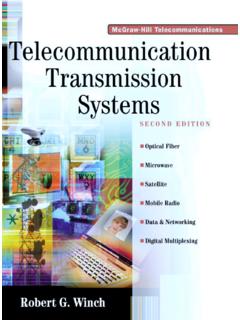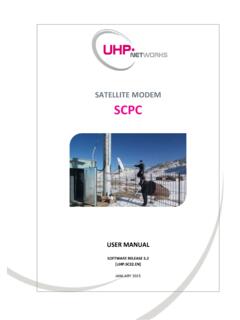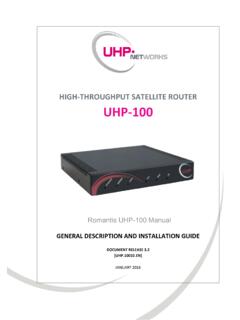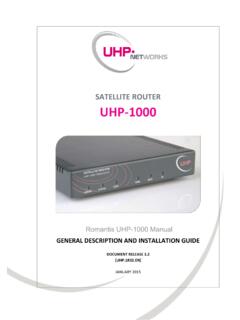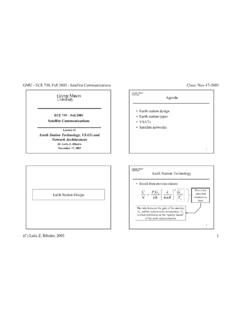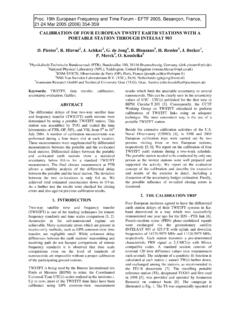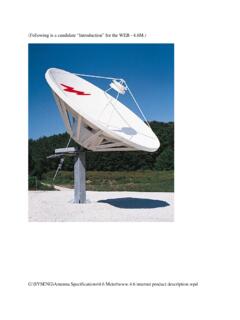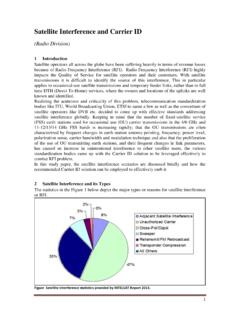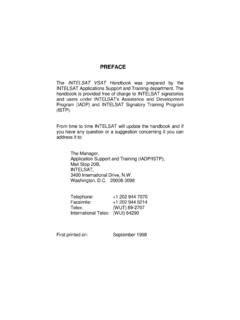Transcription of VIA ELECTRONIC FILING 445 12th Street, SW Re: Intelsat and ...
1 Henry Gola February 14, 2018 VIA ELECTRONIC FILING Marlene H. Dortch Federal Communications Commission Office of the Secretary 445 12th Street, SW Washington, DC 20554 Re: Intelsat and SES Notice of Ex Parte Presentation GN Docket No. 17-183 Dear Ms. Dortch: Per FCC Rule , this letter provides notice that on February 13, 2018, Susan Crandall, Associate General Counsel of Intelsat Corporation ( Intelsat ), Hazem Moakkit, Vice President, Spectrum Strategy of Intelsat , Gerry Oberst, President of SES Americom, Inc. ( SES ), Henry Gola of Wiley Rein LLP, counsel for Intelsat , and Michele Farquhar of Hogan Lovells US LLP, counsel for SES, met with Erin McGrath, Legal Advisor to Commissioner O Rielly, concerning the above-referenced proceeding.
2 The parties discussed the joint proposal by SES and Intelsat for a market-based solution that would free up within 18 months to three years of a Commission order a target of approximately 100 MHz of C-band downlink spectrum in the contiguous for licensed terrestrial mobile operations while preserving critical incumbent satellite uses in the band. The attached overview of this secondary market proposal formed the basis for the discussion. Marlene H. Dortch February 14, 2018 Page 2 Please contact the undersigned with any questions regarding this letter.
3 Respectfully submitted, Henry Gola Wiley Rein LLP Counsel to Intelsat Corporation Attachment cc: Erin McGrath Mid-Band Spectrum NOI, GN Docket No. 17-183 SES- Intelsat The Secondary Market C-Band Proposal SES and Intelsat have jointly developed further details of the market-based proposal initially presented by Intelsat -Intel in the Mid-Band NOI proceeding. The proposal best serves the Commission s policy objectives: bringing highly-valuable mid-band spectrum to market voluntarily, in an efficient and expeditious manner, and with minimal FCC administration while preserving critical incumbent satellite services.
4 Background SES and Intelsat are focused on ensuring that C-band FSS services that are an indispensable backbone of the country s communications infrastructure are protected and preserved. Our customers depend on C-band FSS for a variety of critical services, including: - Delivery of news, sports, and entertainment video and audio programming and emergency alerts to more than 100 million households nationwide - Lifeline communications links to residents of remote areas such as Alaskan bush villages - Offerings by government agencies, both civilian and military, that are vital to public safety, including the distribution of weather data, support for missile warning systems, and communications capacity for Naval vessels - Restoration of services following an emergency.
5 Such as the devastating 2017 hurricanes Any proposal for expanded terrestrial use of C-band spectrum must allow these essential satellite services to continue to be provided with near-perfect reliability. Other options in the record involving co-frequency sharing fail this test. Further, as several parties in the record recognize, co-frequency sharing would preclude terrestrial mobile operations in a significant portion of the country. The Secondary Market C-Band Proposal Overview The Intelsat -SES market-based proposal would create a Consortium of C-band satellite operators to clear and make available a specified portion of C-band downlink spectrum for licensed terrestrial mobile service through secondary market agreements on a market-by-market basis, while maintaining and protecting critical satellite services.
6 The proposal would: - Free up a target of approximately 100 MHz of C-band downlink spectrum, starting at 3700 MHz (with impairment of additional frequencies beyond the cleared spectrum). - Rely on the Consortium to handle the clearing. - Compensate all affected parties (including earth station and fixed microwave operators) for their reconfiguration and relocation costs, as well as prior investment and opportunity costs for Consortium members. Secondary Market Agreements ( SMAs ) The Consortium would negotiate SMAs with prospective terrestrial mobile service providers, who would then apply to the FCC for a Coordinated Mobile License authorizing the provision of terrestrial mobile service in the agreed-upon market area and spectrum block.
7 In exchange for compensation, the Consortium would clear protected incumbent users and contractually relinquish primary protection in the portion of the band covered by the SMA. Mid-Band Spectrum NOI, GN Docket No. 17-183 SES- Intelsat Consortium The Consortium would be open to all C-band satellite operators providing service to all or a portion of the lower 48 states pursuant to FCC-issued licenses or grants of market access. The Terrestrial Licenses The size of the spectrum blocks for each Coordinated Mobile License would be consistent with 5G standards and uniform in each licensed market area.
8 It is expected that the blocks and the technical parameters of the mobile network, designed to facilitate compatibility with satellite services, would be determined by the FCC in a rulemaking based on inputs from the Consortium and potential buyers. - SMAs would be offered on a market-by-market basis, with the ability to aggregate for nationwide coverage. - Af ter execution of an SMA, the prospective mobile carrier would apply to the FCC for a Coordinated Mobile License, which would be conditioned on compliance with any permanent license conditions negotiated by the prospective mobile carrier and the Consortium, including protection of a small number of TT&C/critical teleport sites.
9 - The Coordinated Mobile Licenses would have a renewable term length of ten years (plus the reconfiguration/relocation period during the initial term). Regulatory Changes Needed The FCC would promulgate rules to: (1) add a co-primary allocation to the Table of Allocations for terrestrial mobile service in the C-band downlink spectrum, footnoted to condition such use on reaching an SMA with the Consortium; and (2) by rule, remove primary status protection for incumbent C-band operators in the areas included in a Coordinated Mobile License grant. Incentives The FCC could require annual updates from the Consortium on the SMAs, the reconfiguration/relocation process, Consortium membership, and the overall program status.
10 The FCC could also seek public comment on the program after a pre-defined amount of time and make any necessary adjustments. Formation and Operation of the Consortium The initial members, SES and Intelsat , would negotiate a Consortium Agreement, and additional eligible C-band satellite operators must become parties to the Consortium Agreement in order to become Consortium members. Eligible C-band satellite operators that elect not to become Consortium members would still have their reconfiguration and relocation costs covered. The Consortium would act in accordance with all applicable antitrust laws.
